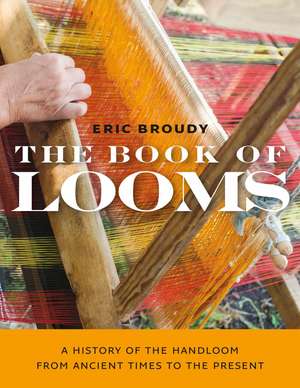The Book of Looms – A History of the Handloom from Ancient Times to the Present
Autor Eric Broudyen Limba Engleză Paperback – 25 noi 2021
The handloom—often no more than a bundle of sticks and a few lengths of cordage—has been known to almost all cultures for thousands of years. Eric Broudy places the wide variety of handlooms in their historical context. What influenced their development? How did they travel from one geographic area to another? Were they invented independently by different cultures? How have modern cultures improved on ancient weaving skills and methods? Broudy shows how virtually every culture has woven on handlooms. He highlights the incredible technical achievement of early cultures that created magnificent textiles with the crudest of tools and demonstrates that modern technology has done nothing to surpass their skill or inventiveness.
Preț: 195.49 lei
Nou
Puncte Express: 293
Preț estimativ în valută:
37.42€ • 38.100$ • 31.15£
37.42€ • 38.100$ • 31.15£
Carte disponibilă
Livrare economică 16-30 decembrie
Livrare express 30 noiembrie-06 decembrie pentru 68.52 lei
Preluare comenzi: 021 569.72.76
Specificații
ISBN-13: 9781684580828
ISBN-10: 168458082X
Pagini: 176
Ilustrații: 153 illustrations, 95 figures
Dimensiuni: 218 x 277 x 12 mm
Greutate: 0.5 kg
Ediția:Nouă
Editura: Brandeis University Press
ISBN-10: 168458082X
Pagini: 176
Ilustrații: 153 illustrations, 95 figures
Dimensiuni: 218 x 277 x 12 mm
Greutate: 0.5 kg
Ediția:Nouă
Editura: Brandeis University Press
Notă biografică
Eric Broudy, a former freelance writer and editor, now devotes his time to fine art photography and public arts management.
Cuprins
Introduction, 1. Origins, 2. The Warp-weighted Loom, 3. The Two-bar Loom, 4. Pueblo and Navajo Looms, 5. The Backstrap and Other Primitive Looms, 6. The Treadle Loom, 7. The Drawloom, 8. The Modern Loom, Bibliography, Index
Recenzii
“Broudy extracts his evidence from such unlikely places as Egyptian tombs to the unearthed ruins of a ninth century Viking ship in Norway. . . . In this awesome feat of research, recounted with storytelling expertise, he traces the growth of weaving from simple matting and wickerwork basketry to the massive tapestry (haute-lisse) looms of the Gobelin workshop of Paris and the silk-producing izaribata looms of China. . . . If you are a weaver by profession or hobby, this book will make you proud of it, and, if you have never touched a loom and are thinking of a new career, this book will, once you tear yourself away from it, send you spinning off to the yarn store.”
“If you are also fascinated by the historical and cultural aspects of weaving, this book should find a place in your library.”
